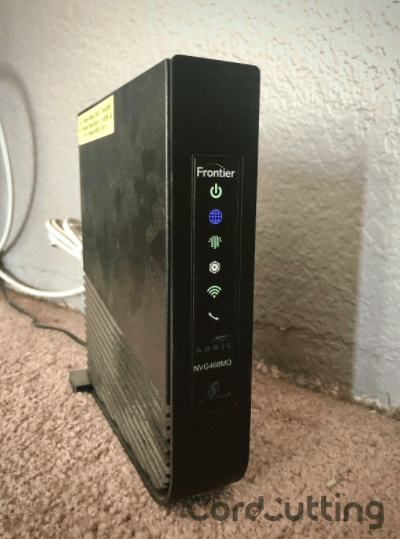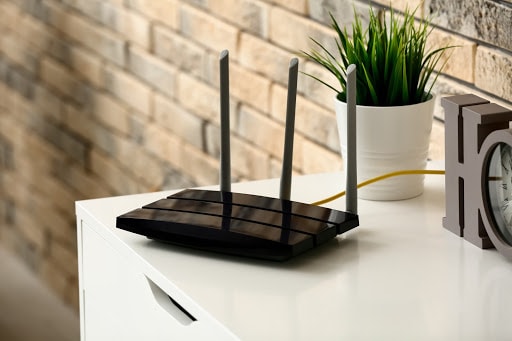The internet is one of the most sophisticated pieces of technology humanity has ever created. Given its complexity, understanding how the internet works can’t possibly be easy, can it?
If you aim to become an internet guru, with a deep and intimate knowledge of every intricacy of the process, your time is probably better spent at a university. If, on the other hand, you want a practical understanding of what happens when you type “CordCutting.com” into your favorite web browser (like Chrome or Firefox), you’ve come to the right place.
In this article, we’ll explain what the internet is, how websites work, how files on the internet know where to go, where ISPs like CenturyLink and AT&T Internet fit in, and what part your modem and router play in this whole process. I hope you didn’t pay for your entire seat, because for the next few minutes you’re only going to need the edge.
What Is the Internet?
In essence, the internet is a giant series of virtual tubes (yes, Ted Stevens had that part right) that connect all of our computers — and other devices — together. Let’s say that you want to send me something like an email or a link to your favorite YouTube video. We’ll call whatever you are sending a “packet,” since that is the general term that we use in internet-explainer land. Here’s how the internet works step-by-step, following the path the packet will travel from your computer to mine.
- The packet leaves your computer and enters your router.
- From your router, the packet continues to your modem.
- Your modem sends the packet to your internet service provider (ISP).
- Your ISP forwards the packet to my ISP.
- My ISP ships the packet to my modem.
- My modem passes the packet to my router.
- My router delivers the packet to my computer, completing the journey.
What we think of as the internet is everything that happens in steps 3-5. The first two and last two steps are important, but they’re not actually happening “on the internet” — instead, they’re happening on the private networks in your house (steps 1 and 2) and mine (steps 6 and 7). We call these private networks “local area networks,” or LANs. We’ll wrap them into the overall discussion, even though they’re not technically on “the internet.” After all, you can’t access the internet without going through your LAN. Your personal Wi-Fi network is a part of your LAN, and you can think of your home network as being a bit like your driveway: It’s a private network that is your access point to a public network, just like your driveway is a little private road that gives you access to a public road system.
If you are disappointed with this answer, don’t worry — we’re only getting started. It’s one thing to know the path that packets are traveling, but the bigger question is: How do the packets know where to go? We’ll get to that and how the internet actually works, but only after an important detour.
How Do Websites Work?
Most of our experience with the internet doesn’t involve sending packets to one person. Instead, we post on social media apps like Instagram, stream content on Netflix, or visit our favorite websites. So how do apps work? Where are the websites?
Let’s start with answering that last question. Websites are stored on computers. With a little technical know-how, you could host a website on your computer right now. Any computer connected to the internet is technically capable of hosting a website that anyone in the world can access.
What about apps? For the purposes of this discussion, they act just like websites. Everything you see on the internet — from your favorite blog post to the meme your friend just shared on Facebook — is on someone’s (or some company’s) computer.
Web-hosting Providers
Any computer can hold a website or app, but most websites and apps aren’t stored on ordinary computers like yours and mine. Instead, they are stored on specialized web “servers” that are maintained by hosted providers like GoDaddy, HostGator, or Amazon Web Services (AWS). If you are picturing one of those giant server rooms from a movie like “Skyfall” or “Tron: Legacy,” you’re close, but scale up that picture by a lot. GoDaddy has over 37,000 servers spread across their nine facilities, and AWS’s server count is in the millions!

Back to the Packets
When you go to a website, you are really asking the web server to send you a packet (a piece of data) just like the one that we talked about earlier. In fact, your request to get the website is also a packet sent from your computer to the website. It responds with a packet containing the website, which is disp/layed in your web browser. And both of those packets travel, using exactly the process we outlined earlier: from a local network’s router, through a modem to the open internet, and then into another modem somewhere else and over another private network.
How Do Internet Packets Know Where to Go?
I want you to drive to my favorite diner. You know where it is, right? Oh, I guess I should give you an address. Luckily, every building has its own unique address.
The internet works essentially the same way. Every device connected to the internet has its own unique address, known as an internet protocol (IP) address. This website has an IP address. Your computer has an IP address. My phone has an IP address. Anything that sends or receives information from the internet has an IP address. Much of the infrastructure of the internet is devoted to assigning these addresses and helping packets find the addresses they are looking for.
Are IP Addresses the Same as URLs?
You are probably thinking to yourself “Wait, I don’t enter an IP address when I go to a website. I just type in the website’s name.” That’s absolutely correct. The designers of the modern internet recognized, and I think we’d all agree, that memorizing IP addresses is just not practical. Instead, they designed the uniform resource locator (URL), also known as a website address or sometimes a website name. (Note there is a subtle difference there: “CordCutting.com” is our website name and also happens to be our URL, but “Ebay” and “Google” are just website names because they’ve left off the “.com” part that would make them URLs).
There are servers on the internet known as domain name system (DNS) servers. They exist to translate URLs into IP addresses. When you type in something like “www.google.com,” your web browser doesn’t know where that is, but it recognizes that you are using a URL. It then goes and asks one of the DNS servers to translate that URL. The DNS server responds with an IP address, so now your browser knows how to find Google’s web server to send them the initial packet.
Who Runs the Internet?
The internet is an awfully big thing. Who is in charge of all of this?
The short answer is … nobody! No one person or organization controls the web. That’s not to say that there are no rules at all, though. The internet is governed by an international, decentralized group of organizations from the private sector, governments, academia, and several national and international organizations. I know that sounds like a vague answer, but it’s because there is no specific answer that would be accurate.
This isn’t as unusual as it sounds, though. Another huge network — the worldwide telephone system — is run similarly. There’s no one governing body that rules over every phone line, but there are plenty of regulations in individual countries that govern things like where telephone lines go and how much phone companies can charge (in some countries, you might even want to watch what you say when you’re using a phone).
One area of regulation that we should talk about in more detail is control of the DNS. The DNS, as you remember from an earlier section, is the system that tells us which IP addresses go with which URLs — the things that translate familiar URLs like “CordCutting.com” into big bunches of numbers. Why is this regulating DNS so important? Imagine if you typed in “www.google.com” into your browser tomorrow and were redirected to some random website instead of Google’s homepage. If something went wrong with the DNS, that’s exactly what could happen! It needs to be run by an organization that is both capable and trustworthy.
Until 2016, the U.S. government controlled the DNS. Many international organizations did not think a single country should have control, so the entire system was transferred to the Internet Corporation for Assigned Names and Numbers (ICANN), an international nonprofit. The internet may not be run by any single organization, but ICANN now has one of the most important roles in the entire system.
Why Do You Need a Modem and a Router?
Let’s bring the conversation a little bit closer to home. Specifically, let’s take a look at the internet equipment you have in your home and what part it serves in keeping you connected to the world.
To connect to the internet, you typically need two things: A modem and a router (sometimes you’ll have both things combined into one device). So what are those things, and what do they do?
What Is Your Modem Doing?
Your computer doesn’t know how to talk to your ISP directly. It would be impractical to include all of those directions on every single internet-connected device. After all, internet service comes in all kinds of flavors (cable, DSL, fiber, etc.), and each requires different instructions.

Thus, the modem was born. Having a single device in your home that translates outgoing signals from all of your devices and sends them to your ISP — as well as translates incoming signals from your ISP and forwards them to your devices — simplifies the entire process. Modems also make it easier to switch ISPs, since you don’t have to worry about whether each and every one of your devices is compatible with your new ISP. If your modem is compatible, or if your ISP sends you a new modem, that takes care of any compatibility concerns.
What Is Your Router Doing?
It sounds like your modem is doing all of the heavy lifting, so why do you even need a router? Well, if you’re willing to go without certain conveniences, you actually don’t need a router! By the time the modem has finished its job, all of the translation between the ISP and your computer is complete. You could easily just plug your computer directly into your modem. In fact, that was the way things were done back in the days of dial-up internet.

Those of you who survived the dark days of dial-up likely remember one thing though: you could only have one device connected to the internet. In fact, you couldn’t even use the internet and the phone service at the same time because they used the same line!
Routers are designed to allow you to use multiple computers and other devices with a single modem and a single internet connection. They coordinate traffic coming from the modem, ensuring that they are routed (yay, the name makes sense!) to the correct computer based on the initial request. Routers also create a local network between your devices, letting you send packets between your devices without having them go all the way through the internet first.
Most routers also add Wi-Fi capabilities to your network, allowing you to connect devices to your network without an Eethernet cable. You may have noticed the big antenna on your device and wondered what it was for. This antenna is what handles the transmission of these Wi-Fi signals.
So there you have it: The modem transmits, receives, and translates data packets from the internet. The router directs traffic, creating a local network (LAN) that lets more than one device make use of the modem’s abilities at one time. Without a modem, you have no internet; without a router, you have no local network (meaning no Wi-Fi, either).
What Does It Mean if Your Internet Isn’t Working?
As you can imagine, there’s a lot that can go wrong with a process this complicated. It’s truly amazing that it works as well as it does. When your internet is having problems, there are a few different things that could be happening.
- There could be a problem with your Wi-Fi.
- Your router could be malfunctioning.
- Your modem may not be working properly.
- The issue might be with your ISP, in which case you should contact them directly.
- If the problem is with a single website, Downdetector can tell you if the website itself is offline.
What Internet Works in My Area?
If there is one acronym that you’ll probably remember from this article, it was ISP. Without an internet service provider, you can’t get access to the internet. Once your packets get past your modem, everything is handled by your ISP.
In most places, you don’t have a lot of ISPs to choose from. In fact, there are really only a few ISPs that you need to know about in order to find an internet service that works where you live. Here’s the shortlist, along with links that will help you find whether the service is available in your area.
Is There Anything Else I Should Know?
We’ve covered the 10,000-foot view of the internet, but there is always more to know. With the information in this article, you are probably already better versed in how the internet works than most of your friends and neighbors. If that was your goal, you can call it a day.
If, on the other hand, you want to dig deeper, here are a few options.
If you want a practical topic to dive into next, I’d suggest you look into how VPNs can protect your online data packets by encrypting the information in a way that even your ISP can’t read. I didn’t have much space to dig into DNS servers in this article, so you could also take a deep dive into how DNS servers work. If you want something a bit closer to home, there’s a lot to explore in the world of Wi-FI, and you can start by learning about Wi-Fi 6, the latest iteration of the technology.
Keep the intellectual journey going, but don’t be afraid to take a break to enjoy a Netflix binge.